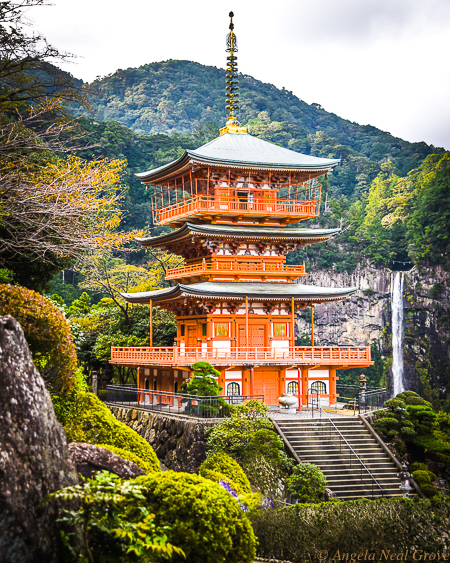
After a jam-packed week in Tokyo, I recently flew north to Sapporo to begin a journey exploring Japan from Tip to Toe.
And what a voyage of discovery. I found picture-book castles and sacred temples, lush forests, simmering volcanoes, bubbling hot springs, ancient trade and pilgrimage routes and, of course, breathtaking gardens.
I fell in love with Japan and plan to return…soon. Here are just a few impressions.

Hokkaido
Hokkaido is the Northernmost of Japan’s four main islands, and the least populated. With 20 volcanoes it is, like the rest of Japan, seismically active – I felt at least 3 earthquakes while I was there.
With volcanoes come hot springs. We spent the night at Noboribetsu in the Shikotsu-Toya National Park. The forest is full of bubbling springs which lulled me to sleep. This water fills Onsen – public warm baths – a Japanese tradition.
Winters are cold here, and powder snow world class. Sapporo was a perfect winter Olympic venue in 1972, and will be again in 2026. Yes, I did try the simulated ski-jump. I think there was something wrong with the machine. It had me falling over both times I tried. I was hoping for a Lindsey Vonn moment.
Only 28 miles from the Russian mainland there is some talk of a bridge linking the two countries.

South to Honshu
Next island on our Tip to Toe adventure was Honshu, and the city of Matsumoto which has one of Japan’s largest wooden, moat-encircled, castles. It was completed in 1593. The city has streets of traditional homes and handicraft shops. Matsumoto was birthplace of artist Yayoi Kusama, renowned for her polka dot pumpkins and infinity rooms. A small museum has some of her iconic works.

Not far from the city is Daio Wasabi Farm, one of the largest in Japan. Long fields with flowing streams wind between trees. Wasabi grows in water, like watercress. I learned much of the “wasabi” in the US is a mixture of grated horseradish and mustard. True Wasabi is milder. We finished our tour of the fields with a wasabi ice cream – it was surprisingly good.

Trade Routes, Shrines and Temples
The next few days were, for me, perhaps the core of the Tip to Toe trip.

We drove the Nakasendo Road through bamboo forests. This old trade route connects present-day Tokyo with Kyoto.
After a visit to the important and spiritual Ise Grand Shrine on a river bank, we checked into the Amanemu in the Ise-Shima National Park. Like many Amans this was perfectly sited, standing on a bluff in Camellia forests. From here were vistas of a fretwork of islands and inlets. Fishing boats dotted the water and the sun, shining through clouds, made patterns on the water.
I hiked in the camellia forest along an ancient pilgrimage route, past stone buddhas and small shrines. Giant multi colored spiders were already spinning halloween webs. Trail signposts are in Japanese and I did take a wrong turn somewhere, but I eventually made it back.

Pilgrimage routes thread through the Kii Mountain Range. The Kumano Nachi Taisha a Shinto shrine, is major pilgrimage site.
We climbed the steep cobbled pathway, a route for over 1,000 years, and gasped at the stunning views from the temple complex on the plateau. We could see the Nachi Waterfall, the highest in Japan. The whole site has UNESCO’s ancient heritage designation.
After this the next sacred, and very memorable, experience was Mount Koya. Here we spent the night in a monastery and rose early to take part in a blessing ceremony.
(Stay tuned for more on this in a follow up post).
Kyushu
Kyushu was the third of our trio of islands. Here the city of Nagasaki has been completely rebuilt since 1945. It was sobering to wander the Nagasaki Peace Park and Museum filled with school children. I wondered what they thought of the devastating images.

Kumamoto was our last stop. To reach it we took a ferry west across Shimbara Wan. The area is a center of seaweed farming, an important element in the Japanese diet. Stakes marked watery plots as far as the eye could see.
The food on this trip deserves a post all to itself. Incredible lobsters, crabs of all shapes and sizes, sashimi, Wagu beef, abalone, bowls of ramen and miso – the delights were endless and the presentation unbelievable.

In some hotels dinner attire was Japanese style. Clothes for us to wear after our onsen baths were set out in our rooms which we were encouraged to wear. I loved wearing Yukata’s for dinner. Each hotel had different patterns, sashes and colors.
Journeys End – Tip to Toe
The last day in Kumamoto was kaleidoscopic. A visit to Mount Aso, Japan’s largest active volcano, and a memorable visit to a traditional bunraku puppetry performance which had us spellbound on the edge of our chairs.
A traditional yakitori lunch was followed by a sake tasting and then tea at Suizenji Park with its beautiful gardens and Shinto Shrine.
And lets not forget dinner which included fresh abalone and wagu beef.
Yes, I fell in love with Japan. My next trip is already booked.

I traveled with GeoEx on this Tip to Toe discovery of Japan. Led by Writer Don George and guided by Akihiro Kasagi
COMING NEXT
Join me for a night in a Monastery on Mount Hoya
Legendary Tsukiji Fish Market, Tokyo, where tuna can fetch $1,000,000 closed Saturday October 6. I was there and have a first hand account.
Loved the photography and descriptions. I never knew Japan had so much to offer tourists.
Thank you so much. It was a very memorable journey. A Pilgrimage of discovery. Hiking forests, meeting farmers and discovering sacred sites left an indeliable impression and a passionate desire to return.